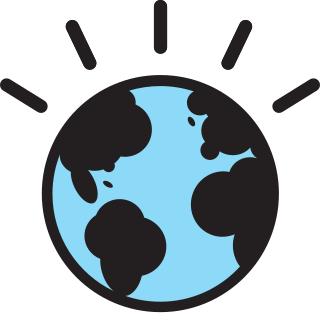Related Research Articles

A wearable computer, also known as a body-borne computer, is a computing device worn on the body. The definition of 'wearable computer' may be narrow or broad, extending to smartphones or even ordinary wristwatches.

A wireless network is a computer network that uses wireless data connections between network nodes.
Smartdust is a system of many tiny microelectromechanical systems (MEMS) such as sensors, robots, or other devices, that can detect, for example, light, temperature, vibration, magnetism, or chemicals. They are usually operated on a computer network wirelessly and are distributed over some area to perform tasks, usually sensing through radio-frequency identification. Without an antenna of much greater size the range of tiny smart dust communication devices is measured in a few millimeters and they may be vulnerable to electromagnetic disablement and destruction by microwave exposure.
Wireless sensor networks (WSNs) refer to networks of spatially dispersed and dedicated sensors that monitor and record the physical conditions of the environment and forward the collected data to a central location. WSNs can measure environmental conditions such as temperature, sound, pollution levels, humidity and wind.
Sensor web is a type of sensor network that heavily utilizes the World Wide Web and is especially suited for environmental monitoring. OGC's Sensor Web Enablement (SWE) framework defines a suite of web service interfaces and communication protocols abstracting from the heterogeneity of sensor (network) communication.
The EnOcean technology is an energy harvesting wireless technology used primarily in building automation systems, but also in other application fields such as industry, transportation, logistics or smart homes solutions. The energy harvesting wireless modules are manufactured and marketed by the company EnOcean, headquartered in Oberhaching near Munich. The modules combine micro energy converters with ultra low power electronics and wireless communications and enable batteryless, wireless sensors, switches, and controls.

Z-Wave is a wireless communications protocol used primarily for residential and commercial building automation. It is a mesh network using low-energy radio waves to communicate from device to device, allowing for wireless control of smart home devices, such as smart lights, security systems, thermostats, sensors, smart door locks, and garage door openers. The Z-Wave brand and technology are owned by Silicon Labs. Over 300 companies involved in this technology are gathered within the Z-Wave Alliance.
Machine to machine (M2M) is direct communication between devices using any communications channel, including wired and wireless. Machine to machine communication can include industrial instrumentation, enabling a sensor or meter to communicate the information it records to application software that can use it. Such communication was originally accomplished by having a remote network of machines relay information back to a central hub for analysis, which would then be rerouted into a system like a personal computer.
Adam Dunkels is a Swedish computer scientist, computer programmer, entrepreneur, and founder of Thingsquare, an Internet of things (IoT) product development business.

SRON Netherlands Institute for Space Research is the Dutch expertise institute for space research. The Institute develops and uses innovative technology for analysis in space, focusing on astrophysical research, Earth science, and planetary research. SRON has a line of research into new and more sensitive sensors for X-rays and infrared radiation.
The Internet of things (IoT) describes physical objects with sensors, processing ability, software and other technologies that connect and exchange data with other devices and systems over the Internet or other communications networks. Internet of things has been considered a misnomer because devices do not need to be connected to the public internet, they only need to be connected to a network, and be individually addressable.
Dust Networks, Inc. is an American company specializing in the design and manufacture of wireless sensor networks for industrial applications including process monitoring, condition monitoring, asset management, Environment, Health and Safety (EHS) monitoring and power management. They were acquired by Linear Technology, Inc in December 2011, which in turn was acquired by Analog Devices, Inc in 2017. The Dust Networks product team operates in the IoT Networking Platforms group of Analog Devices.
Bluetooth Low Energy is a wireless personal area network technology designed and marketed by the Bluetooth Special Interest Group aimed at novel applications in the healthcare, fitness, beacons, security, and home entertainment industries. It is independent of classic Bluetooth and has no compatibility, but Bluetooth Basic Rate/Enhanced Data Rate (BR/EDR) and LE can coexist. The original specification was developed by Nokia in 2006 under the name Wibree, which was integrated into Bluetooth 4.0 in December 2009 as Bluetooth Low Energy.
DASH7 Alliance Protocol (D7A) is an open-source wireless sensor and actuator network protocol, which operates in the 433 MHz, 868 MHz and 915 MHz unlicensed ISM band/SRD band. DASH7 provides multi-year battery life, range of up to 2 km, low latency for connecting with moving things, a very small open-source protocol stack, AES 128-bit shared-key encryption support, and data transfer of up to 167 kbit/s. The DASH7 Alliance Protocol is the name of the technology promoted by the non-profit consortium called the DASH7 Alliance.

Smarter Planet is a corporate initiative of the information technology company IBM. The initiative was formed to encourage the ideas of business, government, and civil society leaders worldwide towards their path of achieving economic growth, near-term efficiency, sustainable development, and societal progress. Examples of smarter systems include smart grids, water management systems, solutions to traffic congestion problems, greener buildings, IBM's goal and strategy is to use the capacity of these technology and process management capabilities and, outside the realm of technology, to advocate for policy decisions that, according to the IBM's management, could "make the planet smarter.
Hewlett Packard Enterprise and its predecessor entities have a long history of developing and selling networking products. Today it offers campus and small business networking products through its wholly owned company Aruba Networks which was acquired in 2015. Prior to this, HP Networking was the entity within HP offering networking products.
The Illinois Structural Health Monitoring Project (ISHMP) is a structural health monitoring project devoted to researching and developing hardware and software systems to be used for distributed real-time monitoring of civil infrastructure. The project focuses on monitoring bridges, and aims to reduce the cost and installation effort of structural health monitoring equipment. It was founded in 2002 by Professor Bill F. Spencer and Professor Gul Agha of the University of Illinois at Urbana–Champaign.

A body area network (BAN), also referred to as a wireless body area network (WBAN) or a body sensor network (BSN) or a medical body area network (MBAN), is a wireless network of wearable computing devices. BAN devices may be embedded inside the body as implants, may be surface-mounted on the body in a fixed position, or may be accompanied devices which humans can carry in different positions, such as in clothes pockets, by hand, or in various bags. While there is a trend towards the miniaturization of devices, in particular, body area networks consist of several miniaturized body sensor units (BSUs) together with a single body central unit (BCU), larger decimeter sized smart devices still play an important role in terms of acting as a data hub or data gateway and providing a user interface to view and manage BAN applications, in-situ. The development of WBAN technology started around 1995 around the idea of using wireless personal area network (WPAN) technologies to implement communications on, near, and around the human body. About six years later, the term "BAN" came to refer to systems where communication is entirely within, on, and in the immediate proximity of a human body. A WBAN system can use WPAN wireless technologies as gateways to reach longer ranges. Through gateway devices, it is possible to connect the wearable devices on the human body to the internet. This way, medical professionals can access patient data online using the internet independent of the patient location.
Intelligent street lighting refers to public street lighting that adapts to movement by pedestrians, cyclists and cars in a smart city. Also called adaptive street lighting, it brightens when sensing activity and dims while not. This is different from traditional stationary illumination, and that which dims on a timer.
Matter is an open-source connectivity standard for smart home and Internet of things devices, which aims to improve their compatibility and security.
References
- ↑ Mullins, Robert (March 15, 2010). "People Power releases SDK for wireless home energy sensors". VentureBeat.com.
- ↑ Lindsay, Greg (February 12, 2010). "HP Invents a "Central Nervous System for Earth" and Joins the Smarter Planet Sweepstakes". FastCompany.com.
- ↑ Hempl, Jessi (April 9, 2010). "Sensor overload". CNN Fortune Brainstorm Tech. Archived from the original on April 12, 2010.